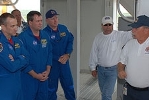Veteran NASA Fire Chief Retires
George Hoggard began his career at the Kennedy Space Center by training the first astronauts to step on the moon. He has been chief of fire training throughout the shuttle era.
A NASA story about the career of George Hoggard explains why he became chief of fire training for the astronauts who begin their missions at the Kennedy Space Center in Florida: The warmer climate appealed to him. Hoggard, a firefighter who began his career at KSC by training the first astronauts to step on the moon, has been chief of fire training throughout the space shuttle era. His retirement party took place one day before shuttle Discovery lifted off for its final mission, designated STS-133 by NASA.
Fire safety has been a critical concern for NASA since its earliest days. A fire during a test on the launch pad claimed the lives of three Apollo 1 astronauts in 1967.
"People who don't know anything about the space program cannot imagine how exciting it is to work out here," Hoggard told KSC's Steven Siceloff. "The very idea of it lasting 30 years never dawned on me and I never did have any retirement plans because working out here is so much fun. Quite frankly, I'm thinking, 'Why would I want to leave this?'"
 Siceloff writes that Hoggard taught astranauts how to handle emergencies on the launch pad or on the ground after a problem. Part of the training for astronauts before each launch is how to drive the yellow M113 armored personnel carriers they would use to drive out of harm's way during an emergency, according to the article.
Siceloff writes that Hoggard taught astranauts how to handle emergencies on the launch pad or on the ground after a problem. Part of the training for astronauts before each launch is how to drive the yellow M113 armored personnel carriers they would use to drive out of harm's way during an emergency, according to the article.
Hoggard served in the Marines and was a police office, like his father and brother, before joining a fire department in southeastern Virginia. A friend told him about construction taking place at KSC. "Quite frankly, I had been on the department up there for eight or nine years and I was tired of freezing on the tail board of a fire engine on Chesapeake Bay in the winter time with the sleet blowing in my face," Hoggard said. "I said, 'If I'm going to continue in this job, I'm going to a warmer climate.' "
The article recounts one of Hoggard's first assignments after he arrived. "I was really new out here and got to go out to the fire training area, and they said three astronauts were going to show up and I didn't know who they were," he told Siceloff. "They did everything we asked them to do with extinguishers and the hose and the masks and stuff, part of the training. And they left and I had no idea who they were, and six months later they stepped on the moon.... It was the Apollo 11 crew."
Hoggard eventually conducted training classes at NASA's other field centers, according to the article. He said preparing and planning the fire safety training for the shuttles was a high point of his KSC career because it was a new challenge shifting from three astronauts to a crew of seven.